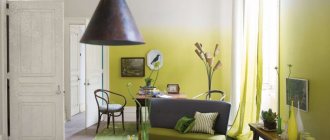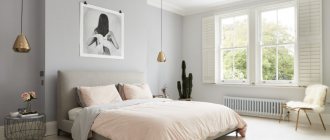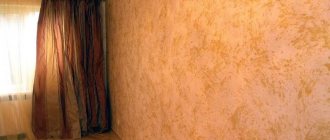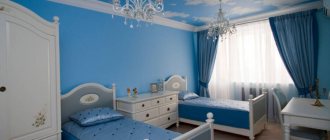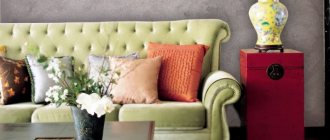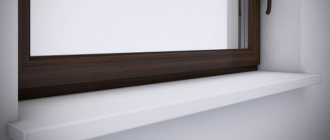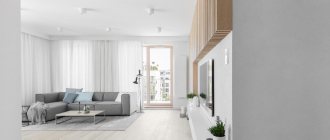Classic version
A familiar, but well-proven method of painting walls in two colors involves dividing the surface horizontally. The border can run exactly in the middle or slightly lower, with the top being painted in a light color and the bottom in a dark color. This technique allows you to perform several tasks simultaneously:
- visually raise the ceiling (a light tone will create the illusion of a vast space);
- make the coating practical (the dark bottom will mask minor dirt well, and the wall will not have to be washed too often);
- This wall design looks very decorative, and on a light background you can advantageously place photographs in frames, paintings or sconces.
Dyeing technology:
The prepared wall is completely covered with a light shade and the paint is allowed to dry. Using a simple pencil, draw a straight line for the boundaries of the flowers and glue them with masking tape so that the marking remains visible along the bottom edge of the paper tape. Next, apply a dark tone, taking a little tape. The paper must be carefully removed within an hour. If the border is not ideal, the situation can be easily corrected with the help of a narrow or wide border, which can be purchased at a building materials store.
Stage five: coloring
Depending on the width of the lines, choose a brush or roller. To paint wide lines, use a roller. Narrow stripes will have to be painted with a brush. The process is labor-intensive but the result is worth it.
If you use colors that are close in color scheme, one coat of paint will be enough. If recoating cannot be avoided, wait until the initial application has completely dried. If there are three or more stripe colors, paint one shade and move on to another tone.
Vertical stripes
The principle of operation is the same, but you will have to tinker a little longer, especially if you decide to alternate narrow stripes with wide ones. You will need very precise markings and careful selection of shades. Sometimes this option is played out using one color, diluted in tone to varying degrees of saturation; There can be more than two shades. The stripes can be the same width or different, but you should know that wide ones are suitable for creating a calm interior, while narrow ones “split” the room.
Advice: in order for such coloring to give an effect that is pleasing to the eye, you should not overuse sharply contrasting colors and shades, then the coating will not be aggressive and will make the room visually higher.
What to consider when combining coloring
The basic rule is a reasonable combination of colors. There are 3 combination options:
- related shades - classic black and white, neutral, pastel cold tones,
- degrade - a transition within one color from dark to light tones,
- a combination of different colors taking into account saturation and temperature.
Combining colors requires care. You will need high-quality masking tape that will protect the surface and come off easily. To decorate less-than-ideal borders, you can use polyurethane molding, paper and stone borders, mosaics and decorative slats. All markings must be made only after the paint has completely dried.
The catalogs present a huge number of shades. But if none of them is suitable for decoration and design, you can create any shade yourself. You just need to do this with a reserve, since it can be difficult to re-mix the desired color.
Horizontal stripes
A good solution for painting walls in different colors is to use horizontal stripes. This technique will allow you to wonderfully decorate a room in a “marine” style, a playful childish style, or even a strict one. Everything will depend on the geometry of the stripes and color scheme. This is a great option for a small room with a high ceiling, as the horizontal lines “pull apart” the walls and “lower” the top a little.
Tip: wide stripes allow the use of a large number of small details in the interior and highlight them favorably, and voluminous monochromatic furniture, plump pillows, large-leaved plants and paintings in wide frames and mats are perfect for narrow stripes.
Think outside the box
Do not think that applying stripes in two directions is the only option. For example, you can arrange the stripes diagonally. In this case, the effect of expanding the space in width will remain, but the ceilings will not seem lower. Another option is to make the stripes broken or make them intersect. The scope for creativity is incredible, and the painting process itself does not change - it all depends on how exactly you create the markings and glue the masking tape.
An interesting idea would be to paint not the entire wall with stripes, but, for example, only the sleeping area. This way you can delimit the space. Well, if you want to make a truly unusual room design, then continue the stripes from the walls to the ceiling.
One lane
This unusual technique has been used to paint walls in different colors quite successfully, but it requires precise design planning and is not suitable for densely packed rooms. A contrasting wide strip running under the ceiling can serve as a kind of frame for spots or other types of lighting.
A horizontal fragment along the perimeter just above the middle of the walls is a good way to highlight wall panels, clocks or other decorative elements. The vertical stripe is often used as a backdrop for shelving or tall outdoor indoor plants.
Diamonds, zigzags, rectangles
Complex geometric designs are also made using masking tape, a roller and a brush, but require a fairly high level of skill. By covering a wall with a diamond-shaped pattern, you can get a very unusual interior, which will have a certain childishness and playfulness.
Zigzags and waves in blue tones will turn the walls into a semblance of sea surf, and the transitions of one to another grassy shades will successfully imitate a green valley.
Rectangles and squares painted in a lighter color seem convex, and in the dark version they resemble niches. This type of decor is often used as a basis for wall lamps.
Accent wall
Painting walls in different colors can be done as simply as possible. A very interesting interior is obtained in a room where only one of the walls is painted in a contrasting shade. This technique is used both for purely decorative and practical purposes. In the first case, the emphasis is placed on one of the walls for the sake of an unusual visual effect, and in the second, the room is thus zoned.
Zoning is a conditional division of space into areas with different purposes. In the relaxation area there can be a sofa or armchair, a small table and a TV, and the workplace is equipped in accordance with the nature of the activity (computer or sewing machine, easel or drafting table, etc.).
It is important to combine colors correctly so that walls painted in 2 different shades do not “argue” with each other, despite the contrast. You can choose a combination of colors for painting walls by learning which colors harmonize with each other and how colors affect our perception.
Examples in the interior: Living room
In a spacious living room, you can give free rein to your imagination and paint the walls with wide and narrow, bright and pastel stripes. In a small room it is better to give preference to light stripes of strict geometric shapes.
Most often, the room has one striped wall, which is an accent in the sofa or TV area.
Wood-look stripes in a stylish living room Source roomester.ru
Harmonious combination of colors in the living room Source gazeta-pravo.ru
Bedroom
Narrow stripes of soothing colors at the head of the bed create an interesting effect in the room without distracting the attention of those relaxing on the bed.
It is preferable to use calm and gentle colors - pink, beige, cream, gray, blue or green.
Spacious bedroom with a bright wall Source gazeta-pravo.ru
Stripes of delicate flowers in the bedroom Source dekormyhome.ru
Children's
A room for kids can be decorated in bright, but not flashy colors, such as yellow, pink, blue, orange. Stripes on the walls allow for proper zoning of space.
For teenagers, you can use calmer combinations of white-blue or white-violet stripes.
Black and white stripes in a bright nursery Source uutvdome.ru
Young researcher's room Source uutvdome.ru
One color in different tones
This type of combined painting of walls in an apartment is called “gradient”. To get tones of a certain color that are different in fullness, you need to use one single pigment to tint the white coloring base, just add it in different proportions. For example, a minimum of blue color in a can of white paint will give a pale blue tint; a little more – sky blue; a little more - cornflower blue and, finally, you can get bright ultramarine. Four shades for four walls.
Tip: it is better to apply the lightest tone on the wall with the window, and the darkest one on the surface opposite it.
Color meaning
When painting walls in several colors, you should pay great attention to the choice of shades and combine them correctly. There are, of course, many options, but here are a few facts that will help determine the general trend:
- “cold” shades (predominance of blue) can visually expand the space, but if you do not dilute them with “warm” touches, the room may turn out to be too office-style;
- “warm” tones give a feeling of comfort and are conducive to relaxation, but it is also useful to shade them and emphasize them with “cold” strokes;
- to decorate children's rooms, it is better to choose calm and natural shades of green, pink, yellow and blue;
- It is not recommended to use “poisonous” colors in a residential area to paint large surfaces;
- black and white classics are a win-win option for the living room, and a few bright spots in such a laconic interior will make it not boring and stylish.
How to paint the walls and what color scheme to choose for the design of an apartment is a rather difficult decision, because sometimes not one, but several options seem very tempting. To finally decide, you can make several color sketches on paper and look closely at each of them for a while. Most likely, in a few days the choice will become obvious.
Features of using stripes in the interior
In order for stripes to decorate the interior, you need to remember a number of features and rules:
- Vertical stripes visually add height to the room, while horizontal stripes make the room appear larger, but lower.
- If the stripes are found on several surfaces of the room, they must match in color, size or nature of application.
- In order for the room to look holistic, it is advisable to use stripes not only on the wall, but also on furniture or accessories.
- Striped walls create a successful combination with a surface painted in the color of one of the stripes.
- It is preferable to design many thin stripes in a calm color scheme so as not to create ripples in front of the beholder’s eyes.
- As a general rule, it is advisable to only stripe one wall or area of the room. There is a bold option for placing stripes on the ceiling, which adds height to the room.
Striped walls in a cozy living room Source gazeta-pravo.ru
There are a number of varieties of stripes:
- Vertically. Using the right combination of color and size of stripes, you can visually make the room taller.
- Horizontally. In a narrow and high room it creates the illusion of expanding space.
- Diagonally. This option is ideal for rooms with a non-standard layout or rooms in the attic.
Depending on the size and design, stripes are divided into several categories:
- Wide. The style suits any spacious room.
- Narrow. Ideal for minimalist rooms where calm colors predominate.
- Plain. A calm option for classic rooms.
- With sparkles. Ideal for drawing attention to a specific area of the apartment.
- With a pronounced texture. Used on an accent wall in combination with plain wallpaper. Add volume to the room.
- With floral motifs. Preferred for bedrooms.
- With drawings and patterns. Depending on the nature of the image, it can be used in any room.
Geometric patterns in the nursery Source roomester.ru

